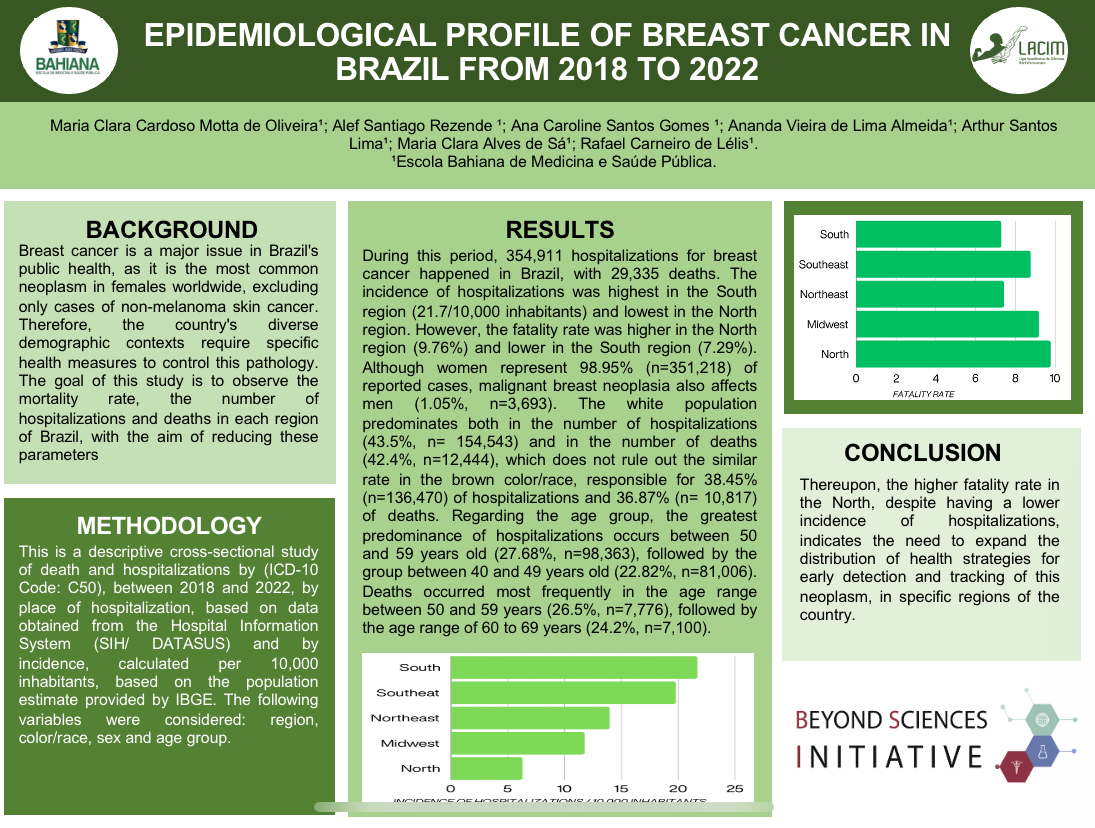Maria Clara Oliveira
Conference 2024 Poster
Poster Title
EPIDEMIOLOGICAL PROFILE OF BREAST CANCER IN BRAZIL FROM 2018 TO 2022
Authors and Affiliations
Maria Clara Cardoso Motta de Oliveira1, Maria Clara Alves de Sá1, Ananda Vieira de Lima Almeida1, Arthur Santos Lima1, Ana Carolina Santos Gomes1, Alef Santiago Rezende1, Rafael Carneiro de Lélis1
1. Department of Medicine, BAHIANA – School of Medicine and Public Health, Salvador, Brazil
Abstract
Background
Breast cancer is a major issue in Brazil’s public health, as it is the most common neoplasm in females worldwide, excluding only cases of non-melanoma skin cancer. Therefore, the country’s diverse demographic contexts require specific health measures to control this pathology.
The purpose of this study is to observe the mortality rate, the number of hospitalizations and deaths in each region of Brazil, with the aim of reducing these parameters.
Methods
Descriptive study with a cross-section of deaths and hospitalizations by (ICD-10 Code: C50), with a historical time series between 2018 and 2022, by place of hospitalization, based on data obtained from the Hospital Information System (SIH/ DATASUS) and by incidence, calculated per 10,000 inhabitants, based on the population estimate provided by IBGE. The following variables had considered: region, color/race, sex, and age group.
Results
During this period, 354,911 hospitalizations for breast cancer happened in Brazil, with 29,335 deaths. The incidence of hospitalizations was highest in the South region (21.7/10,000 inhabitants) and lowest in the North region. However, the fatality rate was higher in the North (9.76%) and lower in the South (7.3%). Although women represent 98.9% (n=351,218) of reported cases, malignant breast cancer also affects men (1.05%, n=3,693). The white population predominates in the number of hospitalizations (43.5%, n= 154,543) and deaths (42.4%, n=12,444), although the brown/color race represents 38.45% (n=136,470) of hospitalizations and 36.87% (n= 10,817) of deaths. Regarding the age group, the greatest predominance of hospitalizations occurs between 50 and 59 years old (27.68%, n=98,363), followed by the group from 40 to 49 years old (22.8%, n=81,006). Deaths occurred most frequently between 50 and 59 years old (26.5%, n=7,776), followed by the range of 60 to 69 years old (24.2%, n=7,100).
Conclusions
Thereupon, the higher fatality rate in the North region, despite having a lower incidence of hospitalizations, indicates the need to expand the distribution of health strategies for early detection and tracking of malignant breast neoplasm, in specific regions of the country.


Leave A Comment